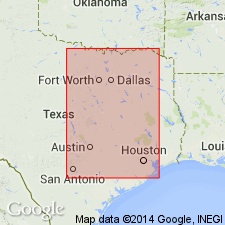
- Usage in publication:
-
- EXOGYRA ARIETINA marl
- Modifications:
-
- [Original reference]
- Dominant lithology:
-
- Marl
- AAPG geologic province:
-
- Ouachita folded belt
Summary:
EXOGYRA ARIETINA marl. Fossiliferous, indurated blue and yellow marl, with occasional bands of gray limestone and thin seams of selenite. Pyrite occurs as small spherical masses and as crystals covering fossils. Fossils include EXOGYRA ARIETINA, GRYPHAE PITCHERI, JANIRA TEXANA, and small DENTALINA sp. (E. ARIETINA abundant at locality on Shoal Creek near Austin, Travis County., central eastern Texas.) Overlies Lower Cretaceous (Comanche) [†]Washita limestone [later abandoned; =Georgetown Formation]. Notable exposure toward base of Mt. Bonnell, near Austin; thickness about 60 feet. Age is Early Cretaceous.
[GNC remark (ca. 1938, US geologic names lexicon, USGS Bull. 896, p. 713): †EXOGYRA ARIETINA clay, †EXOGYRA ARIETINA marl. Paleontologic name for Lower Cretaceous beds in Texas that were later named Del Rio Clay. See Del Rio.]
Source: Modified from GNU records (USGS DDS-6; Denver GNULEX).
For more information, please contact Nancy Stamm, Geologic Names Committee Secretary.
Asterisk (*) indicates published by U.S. Geological Survey authors.
"No current usage" (†) implies that a name has been abandoned or has fallen into disuse. Former usage and, if known, replacement name given in parentheses ( ).
Slash (/) indicates name conflicts with nomenclatural guidelines (CSN, 1933; ACSN, 1961, 1970; NACSN, 1983, 2005, 2021). May be explained within brackets ([ ]).

